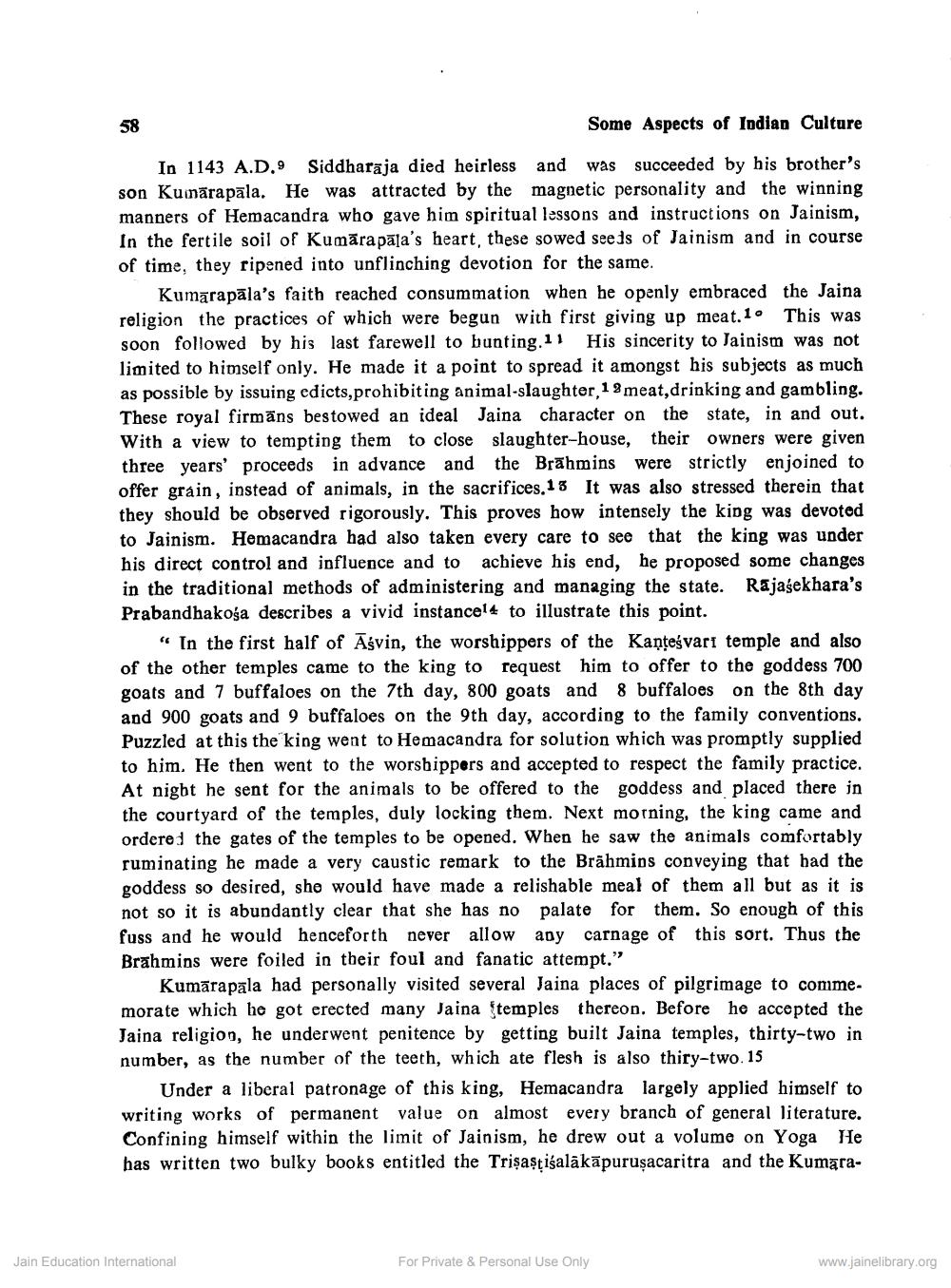________________
Some Aspects of Indian Culture
In 1143 A.D.9 Siddharaja died heirless and was succeeded by his brother's son Kunārapāla. He was attracted by the magnetic personality and the winning manners of Hemacandra who gave him spiritual lessons and instructions on Jainism, In the fertile soil of Kumāra pāja's heart, these sowed seeds of Jainism and in course of time, they ripened into unflinching devotion for the same.
Kumārapāla's faith reached consummation when he openly embraced the Jaina religion the practices of which were begun with first giving up meat.10 This was soon followed by his last farewell to bunting.11 His sincerity to Jainism was not limited to himself only. He made it a point to spread it amongst his subjects as much as possible by issuing edicts,prohibiting animal-slaughter, 18 meat, drinking and gambling. These royal firmāns bestowed an ideal Jaina character on the state, in and out. With a view to tempting them to close slaughter-house, their owners were given three years' proceeds in advance and the Brāhmins were strictly enjoined to offer grain, instead of animals, in the sacrifices. 13 It was also stressed therein that they should be observed rigorously. This proves how intensely the king was devoted to Jainism. Hemacandra had also taken every care to see that the king was under his direct control and influence and to achieve his end, he proposed some changes in the traditional methods of administering and managing the state. Rajasekhara's Prabandhakośa describes a vivid instance14 to illustrate this point.
" In the first half of Āsvin, the worshippers of the Kaņțeśvari temple and also of the other temples came to the king to request him to offer to the goddess 700 goats and 7 buffaloes on the 7th day, 800 goats and 8 buffaloes on the 8th day and 900 goats and 9 buffaloes on the 9th day, according to the family conventions. Puzzled at this the king went to Hemacandra for solution which was promptly supplied to him. He then went to the worshippers and accepted to respect the family practice. At night he sent for the animals to be offered to the goddess and placed there in the courtyard of the temples, duly locking them. Next morning, the king came and ordered the gates of the temples to be opened. When he saw the animals comfortably ruminating he made a very caustic remark to the Brahmins conveying that had the goddess so desired, she would have made a relishable meal of them all but as it is not so it is abundantly clear that she has no palate for them. So enough of this fuss and he would henceforth never allow any carnage of this sort. Thus the Brahmins were foiled in their foul and fanatic attempt."
Kumārapala had personally visited several Jaina places of pilgrimage to commemorate which he got erected many Jaina temples thereon. Before he accepted the Jaina religion, he underwent penitence by getting built Jaina temples, thirty-two in number, as the number of the teeth, which ate flesh is also thiry-two. 15
Under a liberal patronage of this king, Hemacandra largely applied himself to writing works of permanent value on almost every branch of general literature. Confining himself within the limit of Jainism, he drew out a volume on Yoga He has written two bulky books entitled the Trișașțisalākāpuruşacaritra and the Kumara
Jain Education International
For Private & Personal Use Only
www.jainelibrary.org




